

Innovation. La mise sur le marché mondial de nouveautés, de produits et de services nouveaux ou significativement améliorés ;l'adoption en leur sein d'une gestion de l'innovation, aussi basée sur des changements et des mesures internes améliorant[5] leur efficacité et leur efficience.
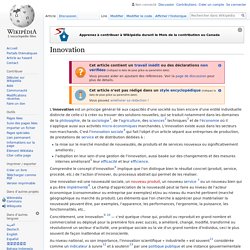
Comprendre le concept d'innovation[6] implique que l'on distingue bien le résultat concret (produit, service, procédé, etc.) de l'action d'innover, du processus abstrait qui permet de les réaliser. Concrètement, une innovation[9],[10] — c'est quelque chose qui, produit ou reproduit en grand nombre et commercialisé ou déployé pour la première fois avec succès, a amélioré, changé, modifié, transformé ou révolutionné un secteur d'activité, une pratique sociale ou la vie d'un grand nombre d'individus, ceci le plus souvent de façon inattendue et inconsciente. Histoire et étymologies du concept et du terme d'innovation[modifier | modifier le code] Joseph Schumpeter. Un article de Wikipédia, l'encyclopédie libre.

Il est l'auteur d'une Histoire de l'analyse économique, parue en 1954 et qui fait encore référence. L’innovation sociale et l’entrepreneur schumpétérien : deux lectures théoriques. Venture capital. In addition to angel investing and other seed funding options, venture capital is attractive for new companies with limited operating history that are too small to raise capital in the public markets and have not reached the point where they are able to secure a bank loan or complete a debt offering.
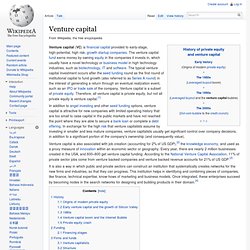
In exchange for the high risk that venture capitalists assume by investing in smaller and less mature companies, venture capitalists usually get significant control over company decisions, in addition to a significant portion of the company's ownership (and consequently value). Vinod Khosla. He is a strong supporter of clean technology and said "If it doesn't scale, it doesn't matter.
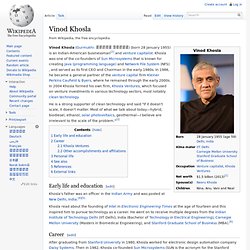
Most of what we talk about today—hybrid, biodiesel, ethanol, solar photovoltaics, geothermal—I believe are irrelevant to the scale of the problem. "[3] Early life and education[edit] John Doerr. L.
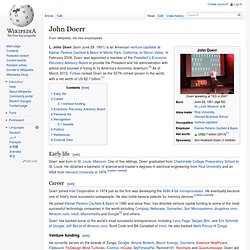
John Doerr (born June 29, 1951) is an American venture capitalist at Kleiner Perkins Caufield & Byers in Menlo Park, California, in Silicon Valley. In February 2009, Doerr was appointed a member of the President's Economic Recovery Advisory Board to provide the President and his administration with advice and counsel in trying to fix America's economic downturn.[2] As of March 2013, Forbes ranked Doerr as the 527th richest person in the world, with a net worth of US $2.7 billion.[1] Early life[edit] Career[edit] Doerr joined Intel Corporation in 1974 just as the firm was developing the 8080 8-bit microprocessor. He joined Kleiner Perkins Caufield & Byers in 1980 and since then, has directed venture capital funding to some of the most successful technology companies in the world including Compaq, Netscape, Symantec, Sun Microsystems, drugstore.com, Amazon.com, Intuit, Macromedia and Google[3] and others.
Upcycling. Upcycling, also known as creative reuse, is the process of transforming by-products, waste materials, useless, or unwanted products into new materials or products of better quality or for better environmental value.
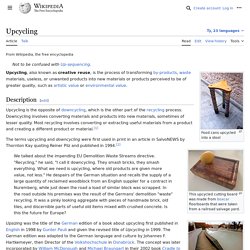
Regenerative design. Regenerative design is a process-oriented systems theory based approach to design.
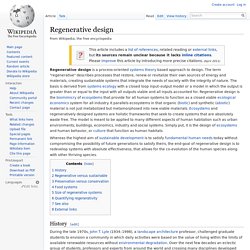
The term "regenerative" describes processes that restore, renew or revitalize their own sources of energy and materials, creating sustainable systems that integrate the needs of society with the integrity of nature. The basis is derived from systems ecology with a closed loop input–output model or a model in which the output is greater than or equal to the input with all outputs viable and all inputs accounted for. Regenerative design is the biomimicry of ecosystems that provide for all human systems to function as a closed viable ecological economics system for all industry. It parallels ecosystems in that organic (biotic) and synthetic (abiotic) material is not just metabolized but metamorphosed into new viable materials.
Ecosystems and regeneratively designed systems are holistic frameworks that seek to create systems that are absolutely waste free. History[edit] During the late 1970s, John T. Green economy. The green economy is one that results in reducing environmental risks and ecological scarcities.
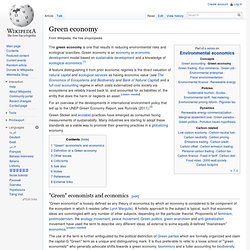
Green economy is an economy or economic development model based on sustainable development and a knowledge of ecological economics.[1] A feature distinguishing it from prior economic regimes is the direct valuation of natural capital and ecological services as having economic value (see The Economics of Ecosystems and Biodiversity and Bank of Natural Capital) and a full cost accounting regime in which costs externalized onto society via ecosystems are reliably traced back to, and accounted for as liabilities of, the entity that does the harm or neglects an asset.
[citation needed] For an overview of the developments in international environment policy that led up to the UNEP Green Economy Report, see Runnals (2011).[2] Social entrepreneurship. Social entrepreneurship is the process of pursuing innovative solutions to social problems.

More specifically, social entrepreneurs adopt a mission to create and sustain social value. Muhammad Yunus. Un article de Wikipédia, l'encyclopédie libre.

Muhammad Yunus. Muhammad Yunus: Create Social Fiction. Downcycling. Downcycling is the process of converting waste materials or useless products into new materials or products of lesser quality and reduced functionality. Downcycling aims to prevent wasting potentially useful materials, reduce consumption of fresh raw materials, energy usage, air pollution and water pollution. Its goals are also lowering greenhouse gas emissions (though re-use of tainted toxic chemicals for other purposes can have the opposite effect) as compared to virgin production. A clear of example of downcycling is plastic recycling, which turns the material into lower grade plastics. The term downcycling was used by Reiner Pilz in an interview by Thornton Kay of Salvo in 1994.[1] We talked about the impending EU Demolition Waste Streams directive.
Circular economy. The circular economy is a generic term for an industrial economy that is, by design or intention, restorative and in which material flows are of two types, biological nutrients, designed to reenter the biosphere safely, and technical nutrients, which are designed to circulate at high quality without entering the biosphere. Scope[edit] Origins[edit] The circular economy is grounded in the study of feedback rich (non-linear) systems, particularly living systems.[2] A major outcome of this is the notion of optimising systems rather than components, or the notion of ‘design for fit’. As a generic notion it draws from a number of more specific approaches including cradle to cradle, biomimicry, industrial ecology, and the ‘blue economy’. Most frequently described as a framework for thinking, its supporters claim it is a coherent model that has value as part of a response to the end of the era of cheap oil and materials. Home - Ellen MacArthur Foundation.
Appropriate technology. The National Center for Appropriate Technology. E. F. Schumacher. Ernst Friedrich "Fritz" Schumacher (16 August 1911 – 4 September 1977) was an internationally influential economic thinker, statistician and economist in Britain, serving as Chief Economic Advisor to the UK National Coal Board for two decades.[1] His ideas became popularized in much of the English-speaking world during the 1970s. Practical Action - technology challenging poverty. Latin America In Peru and Bolivia, we help communities set up small-scale technological solutions in remote areas where there is no access to basic services, including electricity, heating, clean water and sanitation.
Western Africa Building on our recent extension of consultancy work into west Africa, Practical Action has recently set up an office to deliver impact at scale in Francophone west Africa. Eastern Africa. Small Is Beautiful. Small Is Beautiful: A Study of Economics As If People Mattered is a collection of essays by British economist E.
F. Schumacher. The phrase "Small Is Beautiful" came from a phrase by his teacher Leopold Kohr.[1] It is often used to champion small, appropriate technologies that are believed to empower people more, in contrast with phrases such as "bigger is better". First published in 1973, Small Is Beautiful brought Schumacher's critiques of Western economics to a wider audience during the 1973 energy crisis and emergence of globalization. The Times Literary Supplement ranked Small Is Beautiful among the 100 most influential books published since World War II.[2] A further edition with commentaries was published in 1999.
The Blue Economy: Design Theory. The Blue Economy is a design theory initiated by Gunter Pauli which he developed over the last 30 years.[1] Background[edit] The trademarked term [2] for his concept The Blue Economy was brought into life with the book The Blue Economy 10 years - 100 innovations - 100 million jobs.[3][4] It was written by Gunter Pauli after 16 years of experiences and more than 50 successful initiatives and projects all over the world as founder and director of Zero Emissions Research and Initiatives ,[5] introducing the mentality, philosophy and methodology behind the entire concept. Several innovations are described in the context of water, energy, building or food supply. From there on the autonomous term [6] and concept was continued in the books Neues Wachstum[7] and Zen and the Art of Blue,[8] in which blue economy thinking is broken down into things every individual can do every day to live a happier, healthier and more sustainable life.
Principles[edit] 1. 2. 3. 4. 5. 6. 7. The Blue Economy. The Blue Economy: 10 years - 100 innovations - 100 million jobs is a book by Gunter Pauli. The book expresses the ultimate aim that a Blue Economy business model will shift society from scarcity to abundance "with what we have", by tackling issues that cause environmental and related problems in new ways. The book highlights potential benefits in connecting and combining seemingly disparate environmental problems with open-source scientific solutions based upon physical processes common in the natural world, to create solutions that are both environmentally beneficial and which have financial and wider social benefits. The book suggests that we can alter the way in which we run our industrial processes and tackle resultant environmental problems, refocusing from the use of rare and high-energy cost resources to instead seek solutions based upon simpler and cleaner technologies.
Gunter Pauli. Gunter Pauli (2009) Zero Emissions Research and Initiatives. Zero Emissions Research and Initiatives (ZERI) was established by Gunter Pauli in 1994 at the United Nations University (UNU) with the support of the Japanese Government.